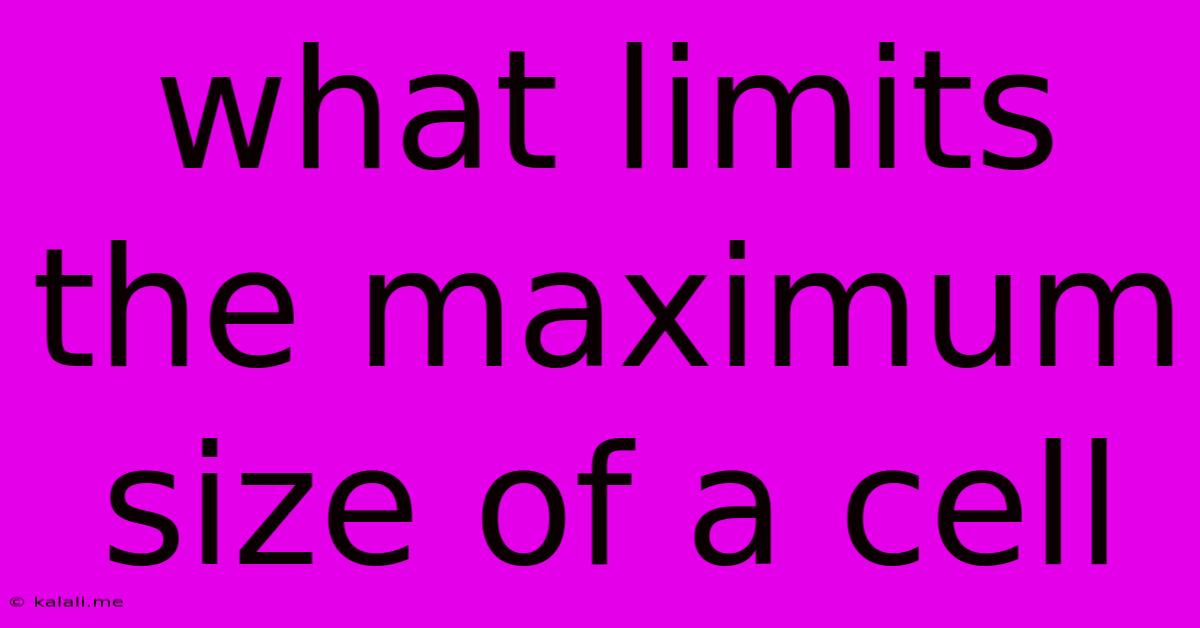What Limits The Maximum Size Of A Cell
Kalali
May 09, 2025 · 3 min read

Table of Contents
What Limits the Maximum Size of a Cell?
Meta Description: Discover the fundamental biological constraints that prevent cells from growing indefinitely, exploring surface area-to-volume ratio, diffusion limitations, and the challenges of DNA replication and management. Learn about the diverse strategies cells employ to overcome these limitations.
Cells, the fundamental building blocks of life, come in a vast array of shapes and sizes. However, there's a striking absence of gigantic cells. Why is there a limit to how large a cell can grow? The answer lies in several interconnected factors that ultimately constrain cellular size and dictate the need for multicellularity.
The Surface Area-to-Volume Ratio: A Crucial Constraint
One of the most significant limitations on cell size is the relationship between its surface area and its volume. As a cell grows, its volume increases much faster than its surface area. This means that the cell membrane, responsible for nutrient uptake, waste removal, and communication, becomes increasingly inadequate to support the metabolic demands of the growing cytoplasm.
Imagine a cube: if you double its side length, the volume increases eightfold (2³), but the surface area only increases fourfold (2²). This disproportionate increase in volume relative to surface area leads to:
- Reduced nutrient uptake: Nutrients must diffuse across the cell membrane to reach the interior. As the cell grows larger, the distance for diffusion increases, slowing down the process and potentially leading to nutrient starvation in the cell's core.
- Inefficient waste removal: Similarly, waste products must diffuse out of the cell. A larger cell faces difficulties in expelling waste quickly enough, leading to a buildup of toxic substances.
- Decreased communication: Cellular signaling relies on the movement of molecules across the membrane. A reduced surface area hinders effective communication between different parts of the cell.
Diffusion Limitations: A Bottleneck for Cellular Processes
Diffusion, the passive movement of molecules from high to low concentration, plays a crucial role in cellular processes. However, diffusion is relatively slow and becomes increasingly inefficient over longer distances. Large cells face significant challenges in relying solely on diffusion for nutrient transport and waste removal, necessitating more efficient mechanisms like active transport. However, these active transport mechanisms also have their limitations and energy requirements.
This diffusion limitation impacts various cellular processes, including:
- Enzyme activity: The availability of substrates and the removal of products influence enzyme efficiency. Diffusion constraints can limit the rate of enzymatic reactions within large cells.
- Gene expression: The transport of messenger RNA (mRNA) and other molecules involved in gene expression can be significantly hampered by diffusion limitations in larger cells.
- Signal transduction: The speed and efficiency of cellular signaling pathways are also affected by the diffusion limitations within large cells.
DNA Replication and Management: A Complex Challenge
As cells increase in size, the demands on DNA replication and management become more complex. A larger cell necessitates more efficient mechanisms for:
- DNA replication: Duplicating the entire genome accurately and quickly becomes a major challenge in a large cell.
- Transcription and translation: The process of transcribing DNA into RNA and translating RNA into proteins requires significant coordination and resource allocation. This becomes more difficult in larger cells due to increased distances between DNA and ribosomes.
- Chromatin organization: Efficient packaging and organization of the genome are crucial for regulated gene expression. Large cells may face challenges in maintaining proper chromatin structure and function.
Overcoming Size Limitations: Strategies of Multicellularity
The limitations of cell size explain why most cells remain relatively small. However, multicellular organisms have evolved strategies to overcome these constraints:
- Cellular specialization: Different cells in a multicellular organism specialize in different functions, minimizing the metabolic demands on any single cell.
- Efficient transport systems: Circulatory and other transport systems deliver nutrients and remove waste, bypassing the limitations of diffusion.
- Communication networks: Complex communication networks allow for efficient coordination between cells.
In conclusion, the maximum size of a cell is constrained by a combination of factors including the surface area-to-volume ratio, diffusion limitations, and the complexities of DNA replication and management. The evolution of multicellularity has provided a remarkable solution to these limitations, allowing for the development of larger, more complex organisms.
Latest Posts
Latest Posts
-
What Is 3 8 As A Mixed Number
May 09, 2025
-
What Is 9 Ounces In Cups
May 09, 2025
-
What Percent Is 90 Of 150
May 09, 2025
-
3 Is What Percent Of 13
May 09, 2025
-
Cuanto Es 150 Mililitros En Onzas
May 09, 2025
Related Post
Thank you for visiting our website which covers about What Limits The Maximum Size Of A Cell . We hope the information provided has been useful to you. Feel free to contact us if you have any questions or need further assistance. See you next time and don't miss to bookmark.